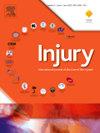Board sport injuries among pediatric patients: A ten year epidemiologic analysis
IF 2.2
3区 医学
Q3 CRITICAL CARE MEDICINE
Injury-International Journal of the Care of the Injured
Pub Date : 2025-03-26
DOI:10.1016/j.injury.2025.112280
引用次数: 0
Abstract
Background
Snowboarding, skateboarding, and water surfing have emerged as popular pediatric sports. While prior work has examined differences among some types of board sports in certain populations, no prior study has directly compared pediatric injury patterns in board sports with similar techniques but on different terrains. The aim of this study was to compare the frequency and severity of orthopedic and craniofacial trauma sustained by pediatric skateboarders, snowboarders, and surfers. These injury types were selected as they encompass the majority of board sport-related trauma, providing a broad overview of injury patterns across different terrains.
Hypothesis
We hypothesized that pediatric skateboarders and snowboarders sustained more fractures and strains/sprains to the upper extremity, while pediatric surfers sustained more injuries to the head and neck.
Methods
The National Electronic Injury Surveillance System (NEISS) was queried for orthopedic and craniofacial trauma related to unpowered skateboarding, snowboarding, and surfing between 2014 and 2023. Annualized trends in injury type, injury location, and injury prevalence were examined over the study period and across sport type. Univariate analyses were utilized to compare injury characteristics and patient demographics across board sport cohorts.
Results
NEISS case criteria identified an estimated 546,231 board sport injuries over the study period. Early-adolescent males were the most commonly injured cohort (76.0 %; CI: 73.8–78.2 %). Fractures to the upper extremity were the most common orthopedic injury among skateboarders (31.6 %; CI: 24.8–38.4 %) and snowboarders (45.7 %; CI: 38.9–52.5 %), while lacerations to the head and neck were the most common injury among surfers (24.5 %; CI: 22.0–26.95 %). Pediatric snowboarders sustained more upper extremity fractures and concussions, but sustained less trauma to the lower extremity.
Conclusions
Findings from this study indicate that pediatric board sport athletes sustain injuries that are analogous but unique. Upper extremity fractures are common in skateboarding and snowboarding. While surfing has a higher incidence of laceration injuries, snowboarding has a higher incidence of concussions but lower incidence of lower extremity injuries. It is important for healthcare personnel to be aware of these injury patterns, especially in settings where immediate healthcare is limited.
求助全文
约1分钟内获得全文
求助全文
来源期刊
CiteScore
4.00
自引率
8.00%
发文量
699
审稿时长
96 days
期刊介绍:
Injury was founded in 1969 and is an international journal dealing with all aspects of trauma care and accident surgery. Our primary aim is to facilitate the exchange of ideas, techniques and information among all members of the trauma team.

 求助内容:
求助内容: 应助结果提醒方式:
应助结果提醒方式:


